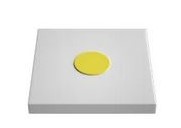Ceramic Phosphor and Phosphor-in-Glass
A ceramic phosphor is a solid element composed of a high density light color converter. Traditional white LEDs use phosphor powders encapsulated in a polymer as a down-converting element. However, such an approach have limitations in achieving high brightness and optical stability due to the low temperature tolerance and poor thermal conductivity of polymers. Solid ceramic phosphors can avoid many of the high power density limitations but can suffer from limitations in light extraction and limited blue light absorption.
Phosphor-in-Glass or PiG can overcome the light absorption and extraction limitations by employing a mixture of phosphor powders in a transparent glass matrix. The PiG approach can still deliver superior thermal conductivity and temperature performance compared to polymer encapsulants. This results in improved luminescence efficacy and long term stability of the phosphor-converted LED (pcLED) or laser-excited phosphor (LEP) device.
A solid ceramic phosphor or PiG color converter can be combined with a blue (or UV) laser and/or LED to generate broadband white with high color rendition (CRI>90) and a wide range of correlated color temperatures (CCTs). In addition, many saturated colors can also be produced using PiG components combined with high energy sources.

Yellow Ceramic Phosphor Disk on White Ceramic Substrate
